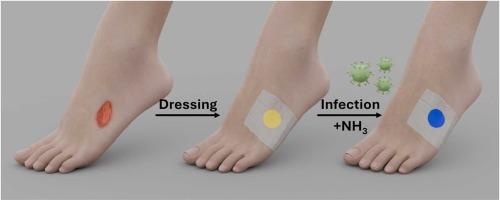Colourimetric sensor for monitoring ammonia-generating infectious bacteria
IF 3.7
1区 化学
Q1 CHEMISTRY, ANALYTICAL
引用次数: 0
Abstract
A simple, inexpensive bromophenol blue (BPB), colourimetric ammonia (NH3) sensor is used to monitor the growth of different wound associated bacteria in three different, simple wound models which utilise a typical, readily available, commercial occlusive wound dressing. The 25 % colour change point of the sensor is ca. 0.0032 %NH3 and its 90 % response and recovery times are, 8 and 230 s, respectively. Using P. stuartii as the test species, in a model wound with an occlusive dressing, the increase in the sensor’s colour up to the 25 % point correlates with that of the exponential growth of the bacterial species (units: CFU/mL) and a simple mathematical model is used to show that a linear relationship should exist between log(CFU/mL) of the initial inoculum and the time it takes for the sensor to reach its 25 % colour change point, the threshold time, TT. This prediction is confirmed using the NH3 producing bacteria, E. coli, E. cloacae, P. stuartii, and K. aerogenes using three different wound models, namely ones in which the ‘wound’ was a non-urea containing agar plug, a urea-containing agar plug and a damaged porcine skin model, respectively. These results suggest that the NH3 sensor has promise as a non-invasive wound monitoring indicator and the additional work required to progress the sensor in this role is discussed briefly.

用于监测产氨感染性细菌的比色传感器
一种简单、廉价的溴酚蓝(BPB)比色氨(NH3)传感器用于监测三种不同的、简单的伤口模型中不同伤口相关细菌的生长,这些模型利用了一种典型的、现成的、商业封闭的伤口敷料。该传感器的25%色变点为0.0032%NH3,其90%响应时间和恢复时间分别为0.8 s和230 s。以斯达氏假单胞菌为试验种,在封闭包扎的模型伤口中,传感器的颜色增加到25%点与细菌种类的指数增长(单位:CFU/mL)相关,并使用一个简单的数学模型来表明,初始接种量的对数(CFU/mL)与传感器达到25%颜色变化点所需的时间(阈值时间,TT)之间应该存在线性关系。这一预测得到了产生NH3的细菌、大肠杆菌、阴沟肠杆菌、石华假单胞菌和产氧克雷伯菌的证实,这些细菌使用了三种不同的伤口模型,即伤口分别是不含尿素的琼脂塞、含尿素的琼脂塞和受损的猪皮模型。这些结果表明,NH3传感器有望成为一种无创伤口监测指标,并简要讨论了传感器在这一角色中的进一步发展所需的额外工作。
本文章由计算机程序翻译,如有差异,请以英文原文为准。
求助全文
约1分钟内获得全文
求助全文
来源期刊

Sensors and Actuators B: Chemical
工程技术-电化学
CiteScore
14.60
自引率
11.90%
发文量
1776
审稿时长
3.2 months
期刊介绍:
Sensors & Actuators, B: Chemical is an international journal focused on the research and development of chemical transducers. It covers chemical sensors and biosensors, chemical actuators, and analytical microsystems. The journal is interdisciplinary, aiming to publish original works showcasing substantial advancements beyond the current state of the art in these fields, with practical applicability to solving meaningful analytical problems. Review articles are accepted by invitation from an Editor of the journal.
 求助内容:
求助内容: 应助结果提醒方式:
应助结果提醒方式:


